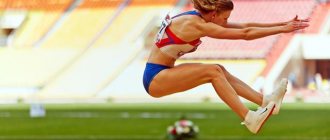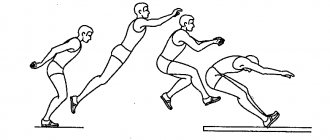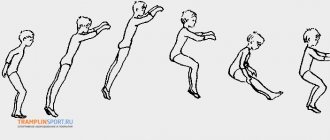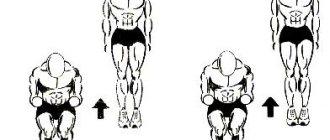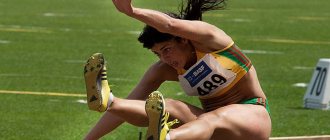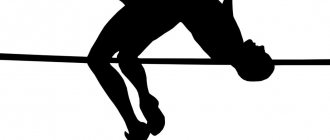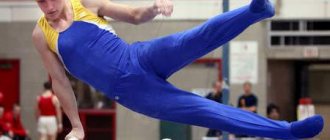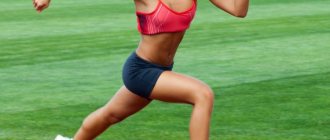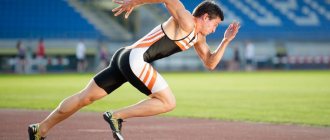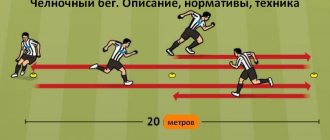History of the development of long jump
This sport first appeared in Ancient Greece. He was part of the main team of Pentathlon. Historians have not been able to determine the exact date of the appearance of running long jumps, but it is known that ancient athletes performed all exercises with a load in their hands. Most often, the additional weight was small dumbbells. Landings were made on loose soil or sand. Official competitions in this sport began to be held simultaneously with the advent of athletics. And already in 1860, jumping was included in the main program of the annual tournament at Oxford University. At the very first competition, a record of 5.95 m was registered. For many years, no one managed to beat this achievement.
However, the British Toswell and Lane are the first professional athletes whose long jump exceeded the threshold of 6 m. One managed to reach 6.40 m in 1868, and the other - 7.05 m (1874). For more than 60 years, Lane's record (7.05 m) has been an example to follow. However, in 1935, the legendary American jumper D. Owen was able to reach the mark of 8.13 m. This record lasted until the 1960s, when the International Athletics Association was created. From that time on, all results and achievements began to be officially registered. As for the women's category, the first record holder was the Japanese Hitomi in 1928, who jumped 5.98 m. The German Schultz surpassed the six-meter mark in 1939 (6.12 m).
Long jump: methods
Today there are 3 types of exercise techniques. These are such running long jump methods as “bend over”, “bent legs” and “scissors”. Each of them requires special skills and flying techniques. The easiest to learn and perform is the long jump with your legs bent. Its main nuance is a reduction in muscle tension in the thighs and abdomen. To do this, the athlete must bend and pull the pushing leg towards the swing leg. The body should be slightly tilted back. In this case, the arms are brought forward first and then up. As the flight path decreases, grouping begins. Your knees should be high and your shins should be loose. The body leans forward, and the arms move from above forward, then down and back. At the moment of landing, the legs should be straightened at the knees. The hardest part of this technique is maintaining balance. The “bending over” method requires long training, since it has a very difficult adjustment when pushing off. During flight, the athlete must lower the fly leg and then extend it as far back as possible. Hands make a circular motion clockwise from bottom to top. At this moment, the athlete finds himself bent in the body. Stretching your abdominal muscles makes it easier to lift your legs when landing. Having flown two-thirds of the way, the jumper must bring his shins as far forward as possible, straightening his knees. The disadvantage of this technique is the fact that athletes cannot realize all their speed capabilities. The above methods of running long jumps are very similar to each other. However, the “scissors” technique belongs to a separate and most complex category. Here, during the flight, the athlete must continue his natural movement (running through the air). According to the rules, the jumper must take at least 2.5 steps. During this action, the body should be slightly tilted back. The arms move in a circular motion asynchronously with the legs to maintain balance. The landing formation is standard.
Repulsion
When pushing off, the foot is placed on the block. This is done by raking a quick movement from top to bottom, as well as back in relation to the body. The foot is always placed in relation to the ground down and forward, almost straight, while the extensor muscles should be tense. Then, under the influence of the inertia of the body weight, the leg bends at the joints, and then straightens it. The swing leg, together with the straightening of the pushing leg, is extended forward and upward from the hip. The long jump continues with the hand of the same name being extended to the side and slightly back, while the other is moved forward and upward and slightly inward. The swing arm is slightly extended at the knee. Immediately after takeoff, the torso is in approximately the same position as it was in after repulsion. Your arms should be slightly lowered. They maintain the balance of the entire body. This position is called "step forward". It continues for more than a quarter of the entire length of the jump. After the “flight in step”, the swing arm drops down, then the push arm is pulled towards it, and the jumper’s knees approach the chest.
When performing a push-off, typical mistakes are the following: incorrect direction of the athlete’s efforts, which is caused by an incorrect tilt of the head (back or forward) and torso at the moment when the push-off occurs; premature pull-up of the jumper's starting leg; a small amplitude of movements carried out by free limbs, as well as early regrouping of the athlete in flight, which is caused by excessive tension in his movements.
Long jump: technique
The main objective of this sport is to overcome the maximum horizontal distance during flight. The technique of performing a long jump requires an acyclic structure of movement.
The effectiveness of training is determined by the athlete’s ability to develop his speed qualities. The key to success in the long jump is not only the ability to quickly run up and push off strongly, but also the ability to move correctly during flight. This is the only way to achieve high results in this type. Landing technique is also important. Professional track and field athletes most often use jumping methods such as “bend over” and “scissors”. The reason for using them is for greater efficiency in flight. The technique of performing a long jump using any of these methods requires a high level of skill, excellent speed and strength qualities. A well-developed coordination system is also important. In educational institutions, the easiest way to exercise is “bent legs”. Long jumps, the teaching method of which does not require much time and special skills, are very easy to perform even at a young age (9-10 years). During physical education classes, the teacher should draw the attention of beginning athletes to flight and tuck techniques. Otherwise, there is a high risk of injury. The long jump phase is divided into several stages. First, a run-up and repulsion are made, after which the flight begins. The final stage will be landing.
How to do a run-up correctly
The main indicator of this action is speed. The range of his flight, that is, the final result, directly depends on how quickly the athlete runs. Each athlete chooses the distance to the take-off point and the number of steps taken. These are individual characteristics that are based on the physical characteristics of the jumper. Professional athletes take approximately 22-24 steps when running at a distance of 50 m. For women, the distance from the starting point to the take-off line is 40 m. They conquer this distance in 20-22 steps. In amateur categories (for example, physical education), long jumps begin with a run of 20 m. In this case, the number of steps taken is not taken into account. The run-up is conventionally divided into 3 components: start, acceleration and preparation for take-off. The first stage can be from a standing position or from an approach. The start of the run sets the further pace and strength of the jump, so special attention must be paid to it. When starting from a standing position, the athlete begins moving from a specific mark, placing one leg in front of him and the other back on his toe. The important point here is the swing. When moving the body back and forth, the athlete deliberately shifts the center of gravity, establishing optimal balance. Starting from an approach requires hitting a control point with a certain foot, after which the run-up begins to be taken into account according to generally accepted rules.
When picking up speed, the amplitude of the legs and arms should be as wide as possible. It is important that the tilt of the body reaches 80 degrees. By the end of the acceleration, the body should take a vertical position. During the run, you must move strictly in a straight line, so that later you can push off comfortably and strongly from the track. A few steps before the start of the jump, the acceleration speed should be maximum. At this time, the shoulders should be tilted back and the pelvis should be pushed forward much further.
Text of the book “Athletics: Fundamentals of Knowledge (in Questions and Answers)”
To maintain speed and direction of movement when entering a turn, the runner assumes a position in which the centrifugal and centripetal forces are balanced. To do this, he tilts his torso forward and to the left, places the foot of his right foot on the path with a slight turn to the left, strengthening the work with his right hand inward, and with his left slightly outward as it moves forward. There is also a more pronounced rotation of the body around the vertical axis to the left.
When holding cross-country competitions, walking and running techniques change depending on the terrain, as well as the properties of the soil . So, when walking and running uphill, the torso leans forward depending on the steepness of the mountain, the length of the step decreases and the frequency of the step increases, the legs are placed on the forefoot. You need to push off with your foot more energetically, while strengthening the work of your hands
. Short climbs are often overcome without slowing down.
When walking and running downhill, the body is in an upright position or leans slightly back, depending on the steepness of the slope. At the same time, the length of steps decreases, the weight of the body is transferred to the leg located behind; the foot is placed on the heel.
When running on hard rocky ground, the step is shortened and the foot is placed on the toe to avoid damage. On soft, especially sandy, soil, it is recommended to run and walk with frequent and short steps, and so that the foot is less stuck in the ground, it is placed on the entire foot.
They jump over obstacles that arise in the form of narrow holes, ditches, and streams while running. When landing, the torso leans forward. Low vertical obstacles are overcome with a “barrier step”, and higher ones are jumped over, leaning on them with your hand and opposite leg.
4.2. Basics of athletics jumping technique
Athletics jumps belong to a group of exercises of a cyclic-acyclic (speed-strength) nature, the goal of which is to overcome the greatest horizontal or vertical space. Based on this, in accordance with motor tasks, long jump and triple jump (horizontal jumps) can be conditionally combined into one group, and high jumps and pole jumps (vertical jumps) into another group.
What determines athletic performance in track and field jumping?
The range and altitude of the athlete's flight path are determined by the take-off speed (Vо ) , take-off angle (
α
) and the height of the center of gravity in the initial position, and the sports result is also determined by the landing technique in long jumps, the technique of crossing the bar in high jumps and pole vaults. The range ( S ) and altitude ( H ) of the OCMT flight path can be approximately calculated using the following formulas:
where S
– length and
H
– height of the GCBM trajectory (without taking into account its height at the moment of departure and landing),
V
– initial velocity of the GCBM in flight, α – angle of the horizontal velocity vector at the moment of departure,
g
– acceleration of a freely falling body,
h
– height of the GCBM in end of repulsion.
From the formulas it is clear that performance in all types of jumps is directly dependent on the square of the initial speed of the body’s take-off and on
the sin of the take-off angle
(doubled in long-distance jumps), since the acceleration of gravity (
g
) is a constant value and is not subject to arbitrary regulation
. The initial departure speed of the GCMT (V o )
is the speed with which the jumper leaves the track and which is formed as a result of the interaction of the jumper with the support.
In this case, a vertical speed is created, a change in the magnitude and direction of the horizontal speed, due to which these two speeds, summed up, create the initial (resulting) speed of the body's departure.
The values of horizontal and vertical speeds in each type of jump must be optimal, based on the corresponding motor tasks. Thus, in high jumps, the horizontal speed reaches 7–7.5 m/s or more. Therefore, at a relatively low horizontal speed, conditions are created for greater upward repulsion in order to ensure the ability to overcome the bar at a high altitude . In long jumps, the horizontal take-off speed reaches more than 10 m/s, and the vertical take-off speed reaches more than 3 m/s.
Therefore, with high horizontal and sufficient vertical speed, the jumper manages to fly a significant distance.
The next value on which the result of the jump depends is the take-off angle, which is determined using the tangent to the flight path at the take-off point or by adding the velocity vectors acquired during the take-off run (V 1 ) and take-off (V 2 ). As a result of the addition, the initial flight speed (V o ) is obtained, the direction of which with the horizontal forms the departure angle
α (Fig. 5).
Rice. 5. Take-off angle (β) and take-off angle (α) in high jump (A) and long jump (B)
The launch angle should not be confused with the take-off angle, which is characterized by the direction of the push at the final moment of take-off. Take-off angle
(β) is the angle formed by the horizontal and the straight line, connecting the athlete’s center of gravity and the take-off point.
Sometimes, for the convenience of practical analysis, it is determined by the inclination of the axis of the pushing leg to the horizontal.
In high jumps
(Fig. 5, A),
the take-off angle approaches 90°, and the take-off angle approaches 60–70°.
In long jump (B),
the take-off angle is 70–80°, and the take-off angle is 16–25°.
These angles are interconnected with the values of horizontal and vertical speed with the technique of pre-push steps, with placing the foot on the ground before pushing off.
During the flight phase, the jumper moves in space by inertia due to the speed obtained during the run-up and push, while experiencing the effects of gravity and environmental resistance. Gravity changes the vertical speed and direction of movement; environmental resistance reduces flight speed.
The jumper's center of gravity in flight moves along a certain trajectory shaped like a parabola.
This trajectory depends on the departure angle, the initial departure speed and the resistance of the medium.
The resistance force of the medium (air) plays a big role at significant speeds in long and triple jumps. According to rough estimates, with a jump length of about 8 m, it reduces the result by 13 cm.
According to the laws of mechanics, relating to a body thrown into space at a certain angle, in flight no internal forces can change the flight path of the athlete’s GCMT.
All this fully applies to athletics jumps.
Any movements in flight can only occur relative to the center of gravity. Therefore, in order for the jump to be more effective, it is necessary to achieve the highest speed of departure of the athlete’s GCMT and direct the flight path at the most favorable angle.
What parts make up the length and height of a jump?
Actual jump length ( L
), which may differ from the result recorded in competitions due to inaccuracy in hitting the take-off place,
is the sum of three segments characterizing the length of the jump
(Fig. 6):
• distance from the toe of the pushing leg to the projection onto the horizontal plane of the athlete’s center of gravity at the moment of completion of the push-off (L1);
• the distance covered by the center of gravity during the flight (until the moment the feet first touch the sand) (L2);
• distance from the projection of the center of gravity onto the horizontal plane at the moment of touching the sand to the landing site (L3).
Rice. 6. Long jump using the “bent legs” method: L1, L2, L3 – components of the jump length
Moreover, the contribution of these segments to the actual (effective) jump length (taken as 100%) is different: for L
1 it measures approximately from 3 to 4%,
L
2 - from 85 to 88%,
L
3 - from 8 to 10%.
The length of each segment is influenced by various factors, which determine the athletic result in the long jump. Thus, the length of the segment L 1 increases with increasing body length and decreasing repulsion angle, and the possibility of increasing this segment due to the noted indicators is very limited.
The largest contribution to the effectiveness of the jump is made by the length of the segment L
2, characterizing the horizontal movement of the center of gravity during flight.
The length of this segment is expressed, in fact, by formula I and depends to a large extent on the initial take-off speed, the take-off angle of the athlete’s WDC, and also, to a lesser extent, on air resistance and the take-off altitude of the athlete.
Length of the last segment ( L
3) is determined by the position of the body and the actions of the athlete when landing.
Thus, it is recommended not to tilt the body forward at the moment of landing, but to keep it straight, which helps to increase the L 3
.
As for the high jump, the result here consists of three main vertical components
(Fig. 7).
Rice. 7. High jump using the Fosbury flop method: H1, H2, H3 – components of the jump height
H
1 – the height of the location of the center body at the moment of separation from the support,
H
2 – the vertical movement of the center body after separation from the support.
The sum of the two above components ( H
1+
H
2) is the maximum height to which the athlete’s GCMT rises during a jump.
H
3 – the efficiency of the bar transition, i.e. the distance between (
H
1+
H
2) and the bar. The last component can be either positive or, in most cases, negative. Let's look at the above components separately.
H 1 depends on the height of the jumper and on the location of individual parts of the body at the moment of completion of take-off.
It goes without saying that in a taller person the CBMT is located higher. The high position of the limbs (flying leg and arms) in the final part of the take-off also helps to increase the position of the center of gravity.
H 2 directly depends on the speed of the center of gravity at the moment of completion of repulsion and on the angle of departure, that is, on the vertical component of the speed of the center of gravity.
The efficiency of the bar transition (H 3 ) is the ability to overcome the greatest possible height with the same height of lifting the GCMT.
As is known, it is impossible to change the trajectory of a jumper’s GCMT in flight. You can only change the position of body parts relative to the center of gravity . The jumper needs to transfer body parts over the bar as high as possible in relation to the highest point of the GCMT trajectory (H 1 +H 2 ), which will allow him to overcome the bar at a greater height with the same height of GCMT lifting.
Indeed, if we compare the “stepping over” and “Fosbury flop” methods, the difference in the result only due to the more economical transition of the bar can be about 40 cm.
The economy of moving the bar in high jumps is ensured by alternate transfer of body parts, which, in the optimal version, allows you to carry the OCMT even below the level of the bar.
The most optimal option is the “snake crawling over an obstacle,” when the parts of the body located on both sides of the bar are lowered down as much as possible. With this option, the OCMT is as far as possible from the boundary of the body located above the bar.
Thus, the altitude of the flight path is determined by formula II (see page 47), which (altitude) can be increased due to two characteristics: both speed and departure angle. Since the possibilities of increasing the height of the jump trajectory by changing the take-off angle are limited due to the lower variability of the latter, an increase in the take-off height of the athlete’s body is realistic mainly due to an increase in the take-off speed.
Describe the main parts of athletics jumping technique
For ease of analysis, the jump technique has four main interconnected parts:
• the first part is the run-up (from the beginning of the movement until the moment the foot is placed at the take-off point);
• the second part is repulsion (from the moment the pushing leg is placed on the support until it is lifted off);
• the third part is flight (from the moment the pushing leg lifts off the support until landing);
• the fourth part is landing (from the moment of touching the landing site until the jumper’s body completely stops moving).
Each of the components of the jump plays a certain role in achieving a high sports result, but their specific weight is not the same. It can be assumed that the most important thing in all jumps is take-off, then the run-up for long jumps, triple jumps and flight for high jumps. Next in order of importance: landing – in the long and triple jumps and run-up – for the “high-altitude” jumpers. The last place in this hierarchy is occupied by such parts as flight when overcoming horizontal obstacles and landing - vertical ones.
It should be emphasized that all parts of the jump are interconnected and represent a single whole. At the same time, in each part of the jump, specific problems are set and solved.
I. Takeoff
During the take-off run, two
tasks are solved: creating the necessary speed at the moment of take-off and optimal conditions for support interaction.
In addition, in long and triple jumps it is necessary to accurately hit the take-off point with your pushing leg. In types of jumps (long, triple, pole), where it is necessary to strive to achieve maximum but controlled speed, the takeoff run is made over a longer segment.
In high jumps, where the conditions for converting horizontal speed into vertical are most difficult, athletes in the run-up gain a lower speed and, accordingly, use a shorter run-up (Table 2).
Table 2 Main characteristics of athletics jumping technique
Conventionally, the take-off run can be divided into two phases: I – starting acceleration; II – preparation and transition to repulsion.
Jumpers begin their run from a place, with several steps of running or walking.
In all types of jumps, the run-up is performed with acceleration, the highest speed is achieved in the last three to four steps of the run-up. The running technique during the starting acceleration is not much different from the sprint running technique; the speed can increase throughout the entire distance or remain after quickly reaching its optimum.
In sports practice, there is an opinion that it is necessary to achieve not the maximum speed for a given athlete, but the so-called “controlled” one.
The latter is also due to the fact that during the competition it is important to maintain the stability of the length and structure of running steps, since one of the conditions for successful competitive activity is to accurately hit the take-off point.
Therefore, despite various disrupting factors (wind, different sector surfaces, etc.), this part of the run must be performed with a strictly defined length and rhythm of steps for each jumper individually. As a rule, as you approach the take-off point, the running pace increases.
In this part of the run, its main task is solved - creating a horizontal speed that is optimal for each type of jump separately. The task associated with preparing for take-off is solved in the last 2-4 steps of the run-up. All the movements of the jumper here are subordinated to one thing - with the least loss of horizontal speed, bring yourself to a position from which you could correctly take off.
This preparation is most noticeable in the pole vault and high vault. A characteristic feature of this run-up phase is a change in the structure of steps, an increase in their tempo, a decrease in the jumper’s center of gravity in the last steps, and running along an arc in a jump using the “Fosbury flop” method.
As a rule, in all jumps the penultimate step is made slightly longer than the previous one, and the last one is shorter by 10–15 cm. Increasing the frequency of steps at the end of the run-up allows you to increase the horizontal speed of the jumper’s center of gravity by the time the leg is placed at the take-off place, and shortening the last step allows you to place the leg closer to the projection of the athlete’s GCMT on the ground and thereby reduce the braking moment of the ground reaction.
All these actions thus contribute to reducing the loss of horizontal velocity in the shock absorption phase, recuperating energy in the muscles and tendons.
II. Repulsion
The main
task of repulsion is to transform the horizontal speed of the body into vertical and create the prerequisites for optimal flight.
Changing direction at high speed with a short time of support requires the jumper to exert great effort when pushing off.
As a result of the redistribution of horizontal speed into vertical speed, the jumper's initial take-off speed is always less than the take-off speed.
The push-off begins from the moment the foot of the pushing leg touches the support. From this moment, the depreciation phase begins, which is then replaced by the repulsion phase. Qualified jumpers place the foot at the take-off site with a wide running movement, almost flat, immediately covering the entire foot and as close as possible to the projection of the center of gravity on the plane of support.
However, if the position is too close, there is a danger of insufficient take-off: the athlete does not have time to develop the forces necessary for take-off, and, as a result, the vertical speed drops, which reduces the result.
At the moment the jumper places his foot, the force of inertia of the movement of his body and the fly links (arms and free leg) creates pressure on the track. This leads to flexion of the leg in all joints and stretching of the tense extensor muscles of the leg (yielding mode of operation), and the active push-off phase begins from the moment when the pushing leg has completed flexion at the knee joint.
It is typical that in long and triple jumps the athlete strives to place his leg straightened at the knee joint on the support. This positioning of the leg has a number of advantages: firstly, the braking forces are reduced due to the oncoming movement of the foot (in relation to the hip joint); secondly, the jumper’s center of gravity begins to rise upward immediately after planting his leg.
As for high jumpers, when they place their foot at the take-off point, their leg is bent more at the knee joint. While depreciation occurs (bending the leg at the knee joint) and the place of support is still in front of the center of gravity, the athlete, vigorously extending the pushing leg at the hip joint, is already actively helping to move the body forward.
In the depreciation phase, it is necessary to reduce the amount of horizontal and vertical forces that arise when placing the pushing leg, prepare the musculoskeletal system for active repulsion and more effectively convert the horizontal speed acquired during the take-off run into vertical flight speed.
In the push-off phase, the muscles work in an overcoming mode. This phase is the most important, since its parameters ultimately determine the speed at which the jumper takes off. The effectiveness of repulsion is determined by the force impulse, which is equal to the product of the average force of interaction with the support and the time of this interaction
. Increasing momentum is more promising through force, since the path for applying effort is still limited.
In all types of jumps, it is important to perform swinging movements with the legs and arms. During the accelerated lift of the swing leg, the reactive force of the swing increases the pressure on the support and increases the load on the muscles of the supporting leg. Then, at the end of the swing, when positive acceleration turns into negative (deceleration) and the energy of the moving swing leg is transferred to the rest of the body mass, the load on the muscles of the supporting leg decreases sharply, which ensures a faster and more powerful contraction.
In high jumps, when taking off, two options for working the arms are used: parallel reach and opposite (cross). The second option corresponds to a faster repulsion. In the long jump, the swing is performed with one hand up and forward; in the triple jump, the swing is performed with both hands and alternately. In the pole vault - moving both arms up and forward. In high jumps, the swing is performed with a slightly bent leg, although with modern high take-off speeds a more pronounced bending of the swing leg is often observed. In long jumps, the swing leg is carried forward, strongly bent at the knee joint. In all types of jumps, up to 70–75% of the GCMT takeoff speed is achieved by the effectiveness of repulsion, and 25–30% by the movement of the swing leg and arms.
Thus, the speed and angle of departure are determined by the most complete use of internal and external forces acting on the jumper’s body at the moment of repulsion. In this case, strict coordination of the repulsion forces and accelerations of the swing leg links is necessary, as well as the sequence of inclusion of individual leg links in the swing execution.
III. Flight
After completion of the repulsion,
flight , in which the jumper's center of gravity describes a certain trajectory, depending on the takeoff angle and initial speed.
Technical difficulties that arise during flight are usually a consequence of incorrectly organized actions during repulsion. The flight part can figuratively serve as a mirror, which reflects all the features of the athlete’s repulsion mechanism. In flight, the jumper moves by inertia and under the influence of gravity. From the moment the athlete separates from the ground, his GCMT should move in a straight line, but under the influence of gravity it moves evenly downward.
As mentioned above, in flight a jumper cannot change the trajectory of the general center of mass of his body with any movements, therefore, he must use flight more rationally to achieve maximum athletic results. Depending on the type of obstacle, the jumpers' tasks will be different.
In high jumps and pole vaults, the athletes’ task is to make the most advantageous use of the flight path of the GCMT and overcome the bar as economically as possible.
The jump is considered completed if the jumper does not knock down the bar.
But crossing the bar does not mean that the athlete’s GCMT was located above the bar. The fact is that the links of the body take turns passing over the bar in flight. Therefore, at each moment of flight, some parts of the body will be located under the bar, and others above it, and as a result, the center of gravity will always be at the level of the bar, above or below it. This speaks to the importance of coordinating the jumper's movements in flight.
At the moment of crossing the bar, the athlete must take a more favorable position for the jump and properly regulate the rotational component of the movement of his body. Thus, in high jumps and pole vaults, the most advantageous movements are those in which the top of the flight path is located exactly above the bar, and the athlete does not transfer the body over the bar immediately, but sequentially, so that the active lowering of some parts of the body contributes to the rise and transfer of others over the bar .
A more advanced technique for overcoming vertical obstacles should be recognized as one in which the difference (in height) between the bar and the top of the GCMT trajectory is the smallest (even better - negative).
Theoretically, in the high jump, just like in the pole vault, it is possible to overcome the bar by carrying the athlete’s GCMT below its level. Calculations show that when using the Fosbury flop method, an athlete can overcome the bar by moving the CGMT 9.3 cm below the level of the bar. It should be added that with this method of jumping, during the unsupported movement, the athlete flies from 2.5 to 3.5 m in length, depending on the height of the bar and the take-off speed.
Other tasks in flight for long and triple jumpers. The desire to land as far as possible forces them to maintain a stable dynamic balance of the body in the air, correcting its orientation and preparing to throw out their legs upon landing.
The fact is that at the moment of transition to an unsupported state after a push, it is difficult to completely avoid some forward rotation of the body around the transverse axis, which occurs during repulsion.
If the rotation is slight, it can be corrected in flight. So, in long jumps, the most effective method is “scissors”, the athlete in flight makes two and a half or three and a half stepping movements with his legs, while his arms make circular movements forward, and the whole body turns slightly back.
This can compensate for the slight forward rotation of the body during repulsion. All movements in flight, reminiscent of running through the air, are natural, follow one after another and flow from the run in coordination.
Thus, the main
task of the long jump in flight is to maintain balance and prepare for landing.
A correct understanding of the essence of the technique of various methods of long jump indicates the need in practical work to direct the main attention to the primary mastery of the take-off technique in combination with the run-up, and not to the design of the flight. It is not the form, but the essence of a sports movement that should be the leading moment in the process of mastering its rational technique.
Rice. 8. Sequence of movements in a triple jump
As for the triple jump (Fig. 8), it includes a “jump” (landing on the starting leg), a “step” and a “jump”. In each subsequent part of the jump, the athlete’s take-off speed decreases by approximately 1.0 m/s, the take-off angles in the “jump” and “step” are somewhat smaller than in the long jump, and in its last part – the “jump” – they are similar to indicators characteristic of the long jump.
IV. Landing
The meaning of landing and the nature of its implementation are not the same in different types of jumps. If in high jumps and pole vaults this part no longer has any effect on the result, then in long and triple jumps the landing plays an important role for the distance of the jump.
In the first two jumps,
the task of landing comes down to ensuring the safety of the jump.
This task is not difficult due to the current use of soft foam mats in landing areas.
Long and triple jumps are a different matter. There are many jumpers here who do not achieve their best results due to poor landings .
The main task for these types of landing jumps is to maintain balance and ensure that the “landing length” is as long as possible (the horizontal distance from the jumper’s center of gravity to the point of contact with the ground).
The requirements for landing technique are contradictory.
So, moving your legs forward, on the one hand, increases the result, and on the other, increases the possibility of falling on your back. In order to prevent such a fall, they move their arms back, and then, when contact with the ground occurs, they are brought forward. More skilled jumpers strive to prepare for an effective landing even mid-flight.
This is ensured by raising the hips, raising the knees high to the chest with a slight tilt of the torso forward. These actions should cause the jumper's heels to touch the ground in front of or coincide with the landing point of the center of gravity. It should be noted that during landing, the athlete’s leg muscles experience, albeit short-term, significant load. In order to reduce the impact of this load and prevent injuries, it is necessary to perform landing movements along the largest possible path.
How to push off correctly
The running long jump technique involves not only acceleration and flight, but also the push itself, which is the key to a good result. How correctly and strongly the athlete pushes off the track, so high will be his final performance. It is worth noting that this part of the jump does not consist of a single ankle push. In fact, repulsion begins with placing the foot on a special boundary mark. At this moment, the foot rests on the outer arch, although some athletes shift the center of gravity directly from the heel to the toe. In any case, the sliding of the foot forward should be from 2 to 5 cm. Optimal take-off in long jumps is achieved by a special position of the foot. The pushing leg should be tilted 70 degrees and the knee slightly bent. This position is not recommended for beginner athletes, since the leg muscles are not yet sufficiently developed and the jumper may lose balance, in other words, not be able to cope with the ground reaction forces that act on his legs and body.
After the initial jerk from the surface, the hip and knee joints extend. At this time, the swing leg is carried forward and upward, fully straightening. This moment is marked by a sharp surge in the load on the jumper’s muscular and inertial system. This position in athletics is called vertical. During repulsion, it is necessary to perform swinging movements with your arms. This will increase the resulting jerk force. The task of repulsion is to achieve the maximum vertical speed of departure from the horizontal movement (take-off run). The faster the dash, the higher the jump height. The optimal launch angle will be 22 degrees. Beginners are allowed any deviation of the body, but only along the axis of movement.
Running jump: what is needed to achieve a good result?
Despite the apparent simplicity of the movements, the running long jump makes a number of serious demands. Without them, it will be impossible to achieve the desired result. The determining factor in achieving good results in this type of athletics is a high level of development of agility, jumping ability, strength and speed. The jumper is faced with the task of not only accelerating as much as possible by the time the foot is planted, but also a more complex requirement - transforming part of the horizontal speed into vertical speed during the push-off process. This requires a high level of development of strength and speed. Thanks to speed, the ability to move in the horizontal plane as quickly as possible is achieved, and jumping ability expresses the ability to throw the athlete’s body in a vertical plane.
Correct flying technique
After the push-off phase from the track, the most difficult part begins for the athlete - movement in the air. Flight is the most difficult element to perform. The running long jump technique requires not only maintaining balance and correct body position, but also creating optimal conditions for landing. The range and balance of the flight directly depend on how the athlete pushes off. The best representatives of this sport reach speeds of up to 10 m/s. In this case, the maximum lifting height is about 60 cm. During takeoff, the push leg should remain behind the body for some time, and the fly leg should be bent to a horizontal level. This running long jump technique can be used in any method, even in scissors. The body should be tilted forward slightly. The arms should be bent and directed along the axis of movement in different directions. The flight phase depends on the method of performing the jump. As for the final stage, the athlete’s torso and limbs must take a special position - tucked. An instant before landing, both legs should be straightened and extended forward, parallel to the horizontal surface. Your arms should move in a circular motion to maintain balance, then move them back as far as possible.
Number of attempts and result measurement
Athletes perform each attempt in turn (6 attempts in total). No more than one and a half minutes are allotted to perform each jump. The winner is determined by the best result shown by him from all six attempts. The result is measured using a tape measure. The zero mark is set at the point closest to the block that was left by any part of the athlete’s body in the sand pit. The result is calculated in whole centimeters, with rounding downwards.
Let us highlight the cases in which the jump is not counted:
1) if the participant ran from the side of the bar or through it;
2) if he stepped on the measurement line with his foot;
3) if the athlete pushes off with both legs;
4) if he touched the ground to the pit during the jump;
5) if the jumper used a somersault in the jump.
How to land correctly
Preparation for this phase of the jump begins the moment the flight path begins to descend. At this moment it is important to group correctly. To be effective, you should hold your legs in such a position that their longitudinal projection is at the most acute angle to the horizontal surface.
The running long jump technique also involves proper contact with the landing area. At the same time, it is important to take care of leaving the flight phase. To do this, it is necessary to relax one leg, towards which the maneuver will be carried out, and at the moment of contact with the surface, turn the body. Care is carried out through the back (back), bringing both the shoulder and arm forward at the same time. It is worth noting that prematurely bringing the torso into this position can lead to lowering of the legs and early contact with the surface.
Possible mistakes
To learn how to long jump correctly, you need to avoid:
You need to choose the right moment to place the pushing leg.
We must not forget about warm-up exercises. Warming up prevents injuries. To learn how to long jump, you need to constantly monitor your health and physical fitness.
Official Rules
Long jump results are determined along a straight axis perpendicular to the bar, starting from the take-off line and ending with the athlete’s trace (any part of the body). Exit from the pit is only allowed to the side or forward. The long jump rules invalidate the result if the athlete steps beyond the line parallel to the bar when taking off. Also, the final results are not counted if the athlete landed outside the pit or left a mark on the plasticine before the flight phase. The first touch of sand will be counted as an intermediate result.
In addition, the long jump rules determine the number of attempts that an athlete can make before his final (best) score is recorded. The number of so-called chances is limited to 6 times. The exception is competitions in which more than 8 athletes participate. In this case, conducts a qualifying round of 3 attempts for each jumper. 8 athletes with the best performance advance to the final stage.
Triple jump
After the run-up, the athlete pushes off from the bar and lands on the same pushing leg, then follows with a step landing on the swing leg and concludes. part – jump with take-off with the swing leg and landing on both legs.
The triple jump has been part of the Olympic program since 1896 (for women since 1996). The most successful athletes were the USA (6 gold), USSR (4), Japan (3). V. D. Saneev (1968–76) was a 3-time Olympic champion; M. Prinstein (Prinstein; USA), A. Ferreira da Silva (Brazil), and J. Schmidt (Poland) won 2 times each. Among women, F. Mbango Etone (Cameroon; 2004, 2008) won at two Olympics. From the fatherland. Repeated world champion T.R. Lebedeva (2000, 2008 – silver; 2004 – bronze) successfully competed among female athletes at the Olympics.
Generally accepted standards
In professional and amateur sports, standards differ markedly. Long jump standards for boys from 9 to 10 years old range from 1.90 to 2.90 m. For girls at this age, the indicators should be in the range from 1.90 to 2.60 m. By the age of 15 for boys the norm is 3.30-3.90 m, and for girls - 2.80-3.30 m. In the semi-professional category (from 18 years old) the figures should be much higher. The standard for running long jump for men is from 3.80 to 4.40 m. For women, the final result must be in the range from 3.10 to 3.60 m. To receive the title of “candidate master of sports”, jumpers must exceed amateur figures almost doubled. For the master of sports, the norm is 7.20 m. As for the “master of sports”, the allowed limit here starts from 7.60 m. The status of master of sports is achieved as a result of grueling long training. The norm for an “international master of sports” is 8.00 m.
Exercises
Exercises for mastering the push-off technique
1. I.p. - main stand, barbell weighing 20-40 kg on the shoulders. Walking with a barbell in wide strides with an emphasis on moving the pelvis forward when placing the pushing leg on a support (30-40 m). The main attention should be paid to a soft and quick “rolling” of the pelvis onto the pushing leg, which should be slightly bent. Perform at an average pace.
2. I.p. - main stand, barbell weighing 20-40 kg on the shoulders. Walking with a barbell with an emphasis on extending the pushing leg and lifting the fly leg, bent at the knee (30-40 m). It is necessary to stretch upward on the pushing leg. The thigh of the swing leg should be parallel to the ground. Perform at an average pace.
3. I.p. - main stand, barbell weighing 40-50 kg on the shoulders. From 2-3 steps of walking, place the jogging leg on the supporting platform (height 20-30 cm) and, pushing off with the flywheel, quickly straighten the jogging leg, followed by lifting the flywheel. Repeat on each leg 10-12 times with an emphasis on moving the pelvis forward. Perform at a fast pace.
Exercises to master the technique of movements in flight
1 I.p. - push leg in front, swing leg behind. With 4-6 running steps, jump over two lines (180-220 cm) in a “step”, followed by landing on the swing leg and running. Repeat 15-20 times. Keep your torso straight. Perform at an average pace.
2. I.p. Same. With 6-8 running steps, jump in a “step” over two obstacles located one from the other at a distance of 90-100 cm and from the place of the push to the first barrier - 180-200 cm. Repeat 8-10 times. Keep your torso straight. Bring your pelvis forward. Perform at an average pace.
Exercises to master landing technique
1. I.p. - push leg in front, swing leg behind on the toe. From 4-6 running steps, long jump with an emphasis on throwing straight legs forward and landing on the buttocks. Take over your feet. Repeat 6-8 times. Perform at a medium to fast pace.
Sets of exercises for the development of speed and strength qualities
1. I.p. - stand on one leg, bend the other at the knee. Jumping on one leg over a bench: a) on the spot; b) moving forward. There are 50-100 hops on each leg. Push off primarily with the foot. Perform at an average pace.
2. I.p. — deep squat, emphasis on the toes, in the hands of dumbbells of 4-10 kg each or a barbell. Jumping. Repeat 8-12 times. Don't tilt your shoulders forward. The body is straight. Emphasis on completing the final part of the push-off. Perform at an average pace with acceleration at the moment of jumping.
3. I.p. - stand on two legs, slightly bent at the knees. Jumping overcoming alternately 4-8 barriers located at a distance of 90-120 cm from one another. Push off with both feet. Repeat 3 times. When jumping over a barrier, keep your torso straight. Perform at an average pace.
4. I.p. — stand on a height of 70-80 cm. The swing leg is in front, the pushing leg is behind. Jumping onto the push leg followed by a long jump. Repeat on each leg 7-8 times. Emphasis on the coordination of the work of the pushing and swing legs. Perform at a fast pace.
World records
The USA clearly leads in the number of athletes with the best performance in this sport. Today the world record (running long jump) belongs to the American Mike Powell. At the open championship in Tokyo in the summer of 1991, the athlete managed to reach the mark of 8.95 m.
A similar record for women belongs to the Soviet jumper Galina Chistyakova. In June 1988, he reached 7.52 m. The absolute world record (running long jump) for the number of phenomenal results belongs to the American Ralph Boston. From 1960 to 1965, he managed to exceed other people's and his own maximum performance 6 times. The only Soviet athlete who could challenge the American was Igor Ter-Ovanesyan. He became a record holder twice in 1962 (in Yerevan) and in 1965 (in Mexico City).
